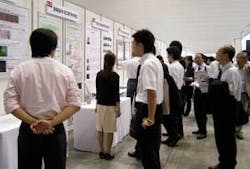The inaugural BioOpto Japan (September 16–17, Yokohama) was held in conjunction with LED Japan Conference & Expo/Strategies in Light and OITDA 2009; together the events drew 7132 people. The three shared a seamless exhibits layout, and the BioOpto conference (see Fig. 1), which featured biomedical optics researchers from all over Japan, was set up right in the exhibit hall. The Japanese-language conference covered topics such as photodynamic therapy (PDT; Prof. Tsunenori Arai of Keio University), medical application of hollow optical fiber (Prof. Yuji Matsuura of Tohoku University), orange fiber lasers (Kasunobu Kojima of Nidek Co. Ltd), optical coherence tomography (OCT; Prof. Masamitsu Haruna of Osaka University), molecular imaging (Prof. Katsumasa Fujita of Osaka University), optical microscopy (Prof. Tomomi of Hokkaido University) and fluorescent protein (Prof. Takeharu Nagai, also of Hokkaido University). In addition, BioOptics World presented a market overview that included commercial and research highlights from North America and Europe.
The conference speakers showcased their research work in exhibits on the show floor as well. Among other exhibitors were numerous product distributors, and a few manufacturers. For instance, Thorlabs Japan (Tokyo) and Santec Corp. (Aichi, Japan) both demonstrated their OCT systems; the latter invited attendees to bring samples to test its IVS-2000 device.
Spectroscopy with no moving parts
NTT Advanced Technology Corp. (Tokyo) attracted attention discussing biomedical applications for its potassium tantalate niobate (KTN) based devices. Researchers at NTT have created a high-speed, voltage-controlled laser-beam KTN scanner (see Fig. 2) with no moving parts that scans in two dimensions in both continuous and step modes, and has a beam deflection of up to 250 mrad (14°) (see laserfocusworld.com/ articles/363451). It can be used with wavelengths in the 532 to 4000 nm range. The company demonstrated a 1D-KTN scanner and debuted its high speed KTN spectrometer, which impressed visitors with its super fast operation speed (less than 1 microsecond) and flexibility (its operation wavelength ranges 450 to 800 nm). “The application covers wide range, for example, an OCT swept light source, fluorescence spectrometer for the reaction of a living body, [and] a laser scanning microscope,” said NTT’s Kazuo Fujiura. Fujiura noted that swept-source (SS) OCT systems from companies such as Thorlabs and Santec include polygon mirrors or galvanic scanners. “We will try to replace these moving mirrors with our KTN scanner,” he said.
The no-moving-parts theme was also in play at the booth where P&P Optica Inc. (Kitchener, ON, Canada) was on hand to discuss its UV/VIS/NIR and Raman spectrometers, which specifically target the needs of researchers and enable measurement of the entire spectrum simultaneously. The company accomplishes this feat through a design based on its gel gratings, which spatially separate the collimating and focusing parts of the system. Meanwhile refractive optics and tight control of scattered radiation eliminate aberrations and stray light that commonly plague spectrometer design. Also important is careful matching of spectral ranges to the capabilities of photodetectors. The result, according to P&P, is a design specially suited to low-light level spectroscopy. For instance, a spectrometer with a 25 mm slit allows simultaneous spectral analysis of signal collected from 144 separate channels–which is especially practical for measuring unstable biological samples. Company president Olga Pawluczyk explains that while P&P produces its core technology (the gel gratings), her company collaborates with Raytheon subsidiary ELCAN (Midland, ON, Canada) for manufacturing services to turn out large volumes of product.
BioOpto Japan 2010 ([email protected]) will take place September 29-October 1, again in Yokohama.
